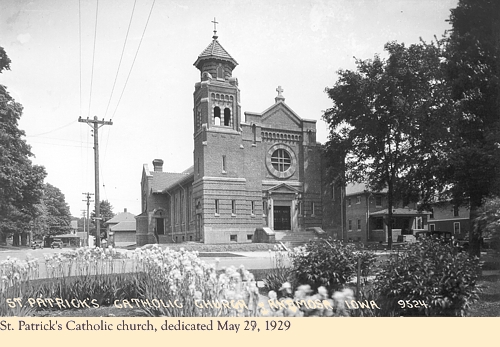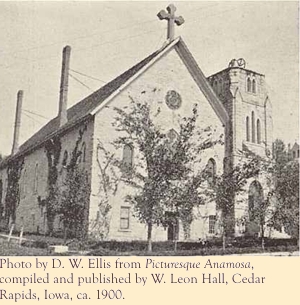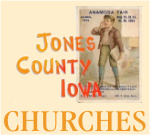
In the early 1850s there were very few Catholics in the southern part of Jones county. Among the few was M. D. Corcoran. He writes: "I came to Jones county, the 15th of April, 1856. For the first year I never saw a person of my race or religion. Then Mr. John Gorman, with four Englishmen, came from Illinois, and joined in a contract to build seven miles of the Air Line Railroad. I hastened to see him. Imagine the joy of meeting a friend in a desert, of Robinson Crusoe meeting a brother on the lonely island! We were the only two Irishmen that either had any knowledge of. It served to form a friendship between us that nothing but death could or did dissolve."
P. McCaffrey and a man named Kelly lived here in 1855, when John Henley (father of Mrs. McGreevy), Phillip Flannery (father of Mrs. Spellmann) and Jas. O'Donnell (uncle of Mrs. B. McLaughlin, Sr.) reached this place en route from Cascade. In the following year P. Wallace, and James Dorsey came upon the scene.The latter journeyed afoot all the way from Farley, carrying his worldly effects in a grip-sack. The winter of 1856-57 was said to be the coldest experience "within the memory of the oldest inhabitant." Cattle were seen standing in the yards frozen fast in death. James Spellman formed one of a searching party who found a family named Wade in the snow frozen on the prairie near Langworthy.
The coming of the railroads in the middle 1850s mark a turning point in the life of Anamosa. Irish and Bohemian immigrants, most of them Roman Catholic came to build the railroads. Some of them stayed to make their homes in Anamosa and the surrounding townships.
The building of the railroad from Farley began in 1857. A large influx of immigrants, anticipating the results, rushed to Anamosa, among them a goodly number of Catholics, merchants, mechanics, laborers, and farmers. (E. C. Holt, Maurice Cavanagh, John Hayes). In 1858 and 1859, as the road was nearing Anamosa, while a few families remained in Langworthy, (Jno. Fleming, M. Mulconery, and M. Doyle) the greater number came and settled in the city (P. Morrissey, Tom English, B. McLaughlin, F. O'Rourke, M. Casey, H. White, John Murphy, Foley Brothers, Chesire Brothers, Gavin Brothers.
Besides the settlers in the city, a far greater number of Catholics cast their lot in the outlying country—Stone City quarries, Fairview, Langworthy, Prairieburg, and the Buffalo Creek prairie. For want of better opportunities, they drove ten or twelve, and some as far as fourteen miles to church. For years the facilities of church attendance were few and far between. When an itinerant missionary happened to pass along, or write before-hand announcing his intended visit, a courier carried the word from house to house, and the little crowd assembled in some shanty or log cabin.
The first house in which mass was celebrated in Anamosa is said to have been a small frame, behind E. M. Harvey's residence. It was owned at the time by Colonel Shaw. He put up the studding, with roof, of a low barn-like structure, in the fall of 1858. When work was stopped by the cold winter weather, he tacked around the outside some pieces of carpet, sheets and paper, and there he made his habitat for a whole year.
The first itinerant priest made his presence known in town, and sought some place to hold services. Colonel Shaw readily offered the use of a building, such as it was, and further offered him the hospitality of his own home whilst the priest stayed here. Early on the following morning, when a few of the Catholic men hastened to the unfinished house, to light a fire, sweep up and fix a table in lieu of the altar, they found that the good colonel had anticipated their intentions, and with his own hands prepared everything in perfect shape for the occasion.
After this, a log house, the residence of James O'Donnell, at the bend of the road, close by the northeast corner of the Driving Park, served the purposes of a Catholic chapel, for some time. They next secured the use of the county courthouse, then located on a knoll at the extreme west end of town, in a frame structure adjoining a two-story brick one, the latter used for other county offices. This courthouse was moved away, and turned to other uses; and for some length of time court was held in the Odd Fellow's hall, east of the Gillen House (hotel). Both the Episcopalians and the Catholics followed. Later on, in a room which was then the "City Hall," over Gordon's Store, in the same block, the same two societies, Episcopal and Catholic, held their Sabbath services successively.
Colonel Shaw donated two lots for a building site for a Catholic church on the corner of First and Garnavillo streets, where the Episcopal and Methodist Churches were afterward located. This property was transferred to the diocese, through Father Slattery, who was then stationed at Cascade, but visited Anamosa, during the building of the railroad, at certain regular intervals. For unknown reasons, these lots were sold, and lots on the hillside on the other end of town purchased.
The first church, at the northwest corner of town, was a simple structure, fifty by thirty feet, without a spire. It was built almost entirely by the free labor of a few devoted members. The senior "Barney" McLaughlin dug the first sod. Thomas Holt, with three sons and a nephew, all expert stonemasons and bricklayers, were not long putting up walls. The only cash contributions were one hundred dollars from Philip Flannery, who was then in the army, where he died and one hundred dollars by Maurice Mulconery, uncle of Maurice Fay, who was roadmaster on the Dubuque & Southwestern Railroad. This money was used to buy brick. The church was completed in 1861, and at its opening was entirely free of debt. A local paper says, "It was dedicated by Bishop Smith (Smyth), assisted by several of the clergy."
In the early 1860s visiting priests came by way of stage, from Cascade, or Temple Hill. Fathers Slattery, Cunningham and O'Connor paid regular visits; also occasionally, Fathers Pickenbrock, Rehnoldt, and in response to special calls Fathers Cogan, of Monticello, Bernard, of New Melleray Monastery, Treacy of Garryowen, Sheils, of Independence, and Paul Gillespie, C.S.C, of Holy Cross, now Key Stone.
After the railroad was built, the clergymen came by rail from the west end of the line. Rev. John Sheils visited for a long period, and at one time had a fixed residence at Anamosa, in a little house at the lower end of town. His first recorded baptism was October 2, 1857, and his last, January 4, 1868. During a gap in his pastorate, Rev. P. V. McLaughlin acted as pastor for a few months from January to May 1867. He also made his residence here, in a small house, off Park avenue to the northwest of Doctor Skinner's.
In 1868 Rev. B. C. Cannon, stationary pastor at Cedar Rapids, paid monthly visits to Anamosa. The next pastor at Cedar Rapids, Rev. Clement Lowery, also made periodic visits to Anamosa, in 1869 and 1870, sometimes on Sunday, and sometimes on week days, as this was one of thirteen missions in his circuit.
Rev. P. J. Maher was born six miles above the city of Waterford, Ireland. He studied at St. John's College in that city and was ordained at Pentecost, 1870, affiliated to the diocese of Dubuque. His first appointment was as pastor of Anamosa, where he arrived to take up his residence in November of the same year. He was supposed by many to be a rather quaint character. At first he boarded at the home of Henry Jackman, and at John Stafford's; later he rented a house south of the Union Depot, where he lived until he built the present pastoral residence on a square acre of ground purchased from Dr. Sales, at the comer of Broadway and High street.
 The foundation of a substantial stone church, one hundred and ten by forty-six, was laid in 1875. The comer stone is inscribed "August 22, 1876." It was made ready for dedication September 12, 1880. Diocesan Bishop Hennessy had come to the city, but was prevented by illness from officiating. He delegated Rev. James Brady, of Farley, to act in his stead. The sermon was by Rev. Thomas Rowe of West Dubuque. Miss Jennie Sales was in charge of the music. Daughter of Dr. Sales, she is now a vocalist in Europe.
The foundation of a substantial stone church, one hundred and ten by forty-six, was laid in 1875. The comer stone is inscribed "August 22, 1876." It was made ready for dedication September 12, 1880. Diocesan Bishop Hennessy had come to the city, but was prevented by illness from officiating. He delegated Rev. James Brady, of Farley, to act in his stead. The sermon was by Rev. Thomas Rowe of West Dubuque. Miss Jennie Sales was in charge of the music. Daughter of Dr. Sales, she is now a vocalist in Europe.
Father Maher also attended an out-mission on the Buffalo Creek prairie, where he built a church two miles south of Prairieburg. He made an attempt to utilize the vacated brick church building in Anamosa for the purposes of a parochial school, but the effort proved a failure.
Rev. Thomas McCormick became pastor at Anamosa, in November, 1881, and remained for more than four years. During his time the Catholic cemetery, which was first a little patch on the hill behind the old brick church, and then moved to a site some two miles outside the city, was moved back, and permanently located on a plat of ten acres on the way to Stone City. The Catholics of Stone City parish cooperate with those of Anamosa in keeping up the cemetery. Father McCormick also began the construction of a bell-tower, which the church up to that time had not had, the bell being set on the ground. He left in January, 1886, and died in April, 1894.
Rev. Robert Powers, who had been three years a pastor resident in another part of the county, came to Anamosa March 20, 1886, and has been rector up to the present time (1909.) St. Patrick's church and parish house have been enlarged, remodeled and modified to such an extent that what little remains of the original is scarcely recognizable. The single acre of ground first bought has spread until it now includes more than ten acres. A sanitarium was built in 1892, and rebuilt after being burned down, in 1902.
Father Powers retired in 1925 and was succeeded by Rev. M. F. Eardley. The following year the church burned down. A new structure was dedicated May 27, 1927, at the corner of N. Garnavillo and Carroll streets, a more central location.
Fr. Eardley was succeeded by the Reverends: J. J. Hehir, D. P. Mulcahy, P. J. Behan, J. A. McMahon, Alfred Brosius, Alphonse White, J. V. O'Brien, W. W. Schmidt, and Richard Gaul.






